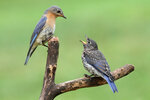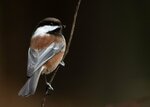


They first visited the bird bath about three weeks ago, those three fledgling Chestnut-backed Chickadees. They were looking goofy, with pin feathers sticking out at odd angles, and wanted to bathe. They also acted goofy, poking each other just like three young brothers. I called them “the brothers,” although one cannot visually identify the sex of these birds.
Initially, I suspect parents were nearby, still providing food. More recently, I think they may now be self-feeding, as there are all sorts of worms and spiders available in the nearby bushes and fruit trees. And they are now looking like serious chickadees.
By the end of July, nesting is over and we’re in the middle of the fledging process, the life stage where young birds have left the nest but are still dependent on their parents.
Birds exhibit two different patterns following egg hatching. The first is precocial – the young are hatched with feathers, eyes open and able to keep themselves warm. Precocial young also must immediately feed themselves (they are precocious, after all). Ducks, geese, shorebirds, quail (and chickens) are examples. Their actions are guided primarily by instinct. They can do most needed activities from hatching; one of the last skills they master is flight.
If you have been near a lake or pond you have probably witnessed precocial young often, whether it is ducklings following their mother or goslings hanging out with their Canada Goose parents. Although they don’t feed their young, they do defend them. I was once chased by an adult goose for getting too close to its young – not an easily forgotten memory.
Most North American shorebirds breed in the far north, where flying insects respond to the summer warmth with their own breeding spree. The young sandpipers and plovers immediately begin feasting on this flying abundance. We have two locally breeding shorebirds, Spotted Sandpiper and Killdeer, and you may have seen them escorting and protecting their young.
The other pattern is altricial, typical of all songbirds and many others. At hatching, these young are very immature, with no feathers, closed eyes, and unable to feed themselves or keep warm. They stay in the nest and must be brooded – that is, covered and kept warm by one or both of their parents – and fed by parents for a number of days until they mature enough to be able to fly.
When I monitored Western Bluebird nests, I was able to track bluebird growth patterns closely. At hatching, they are small and pink, at most an inch in length, and weak. About the only thing they can do effectively is open their mouths and be fed. They grow fast and at four days old are stronger, have doubled in size and able to loudly vocalize to solicit feeding. By about ten days, they have body feathers and can keep themselves warm if they get sufficient food. By 16 days, their wing feathers have grown and by 20 days, they leave the nest box.
However, leaving the nest box is not the end of the parents’ responsibilities. They will feed the fledglings for another 2-3 weeks, leading the small family flock to various feeding areas. Sometimes the pair will initiate a second nesting and the young from their first effort will assist in feeding the second brood.
Learning seems to be more important for bird species following the altricial pattern. Their brains are very undeveloped at hatching, maturing in response to parental feeding and nurturing. Some researchers think that the bird songs we appreciate have evolved with this altricial pattern; songs heard during the long immature period becoming imprinted on the maturing brains of the young birds. This would explain why many songbirds continue to sing long after territories have been established and nesting completed.
Keep your eye peeled for “goofy” looking birds; notice the juvenile swallows lining up on the utility wires waiting for feeding time; listen for what sounds like begging calls; enjoy vocalizations that seem to be odd and not found on the Merlin app. It’s fledgling season, and you never know exactly what might happen.
George Walter is environmental program manager at the Nisqually Indian Tribe’s natural resources department; he also has a 40+ year interest in bird watching. He may be reached at george@theJOLTnews.com
Photos for this column are provided by Liam Hutcheson, a 16-year-old Olympia area birder and avid photographer.
Comments
No comments on this item Please log in to comment by clicking here